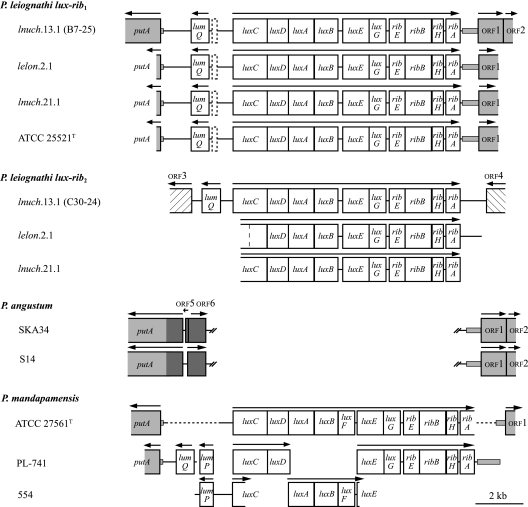FIG. 1.
Gene organization of the lux-rib1 and lux-rib2 operons of P. leiognathi. Genes and spacer regions are drawn to scale. Arrows above genes indicate the direction of transcription. Dashed rectangles between lumQ and luxC in P. leiognathi lux-rib1 sequences indicate an approximately 200-bp region that is alignable to the lumP sequence of P. mandapamensis. Genes shaded gray have homologs in P. leiognathi, P. mandapamensis, and P. angustum. Small shaded rectangles outside of genes indicate noncoding intergenic sequences of P. leiognathi and/or P. mandapamensis that are alignable to sequences in P. angustum strains SKA34 and S14, including approximately 80 bp before the P. leiognathi putA start codon that aligns to a sequence within putA in P. angustum. Genes shaded dark gray in P. angustum indicate regions (orf5, orf6, and 759 bp from the start codon of putA) that are not alignable with a gene or intergenic sequence in P. leiognathi or P. mandapamensis. Double hash marks in the P. angustum sequences indicate contiguous sequences that have been separated to indicate the position of the lux-rib operon in P. leiognathi and P. mandapamensis. Blank regions in P. mandapamensis strains indicate that the sequence is not available; dashed lines in P. mandapamensis ATCC 27561T indicate regions where the DNA was amplified in this study but not sequenced. The hashed rectangles indicate ORFs (orf3 and orf4) flanking the lux-rib2 operon of fosmid C30-24 that are apparently homologous to bacterial transposases (see the text). In lux-rib2 of P. leiognathi lelon.2.1, a dashed vertical line in the region homologous to luxC indicates the site of a single nucleotide deletion that causes a frameshift of luxC in this strain, resulting in a stop codon 18 codons later. See the supplemental material for complete maps of the fosmids.

